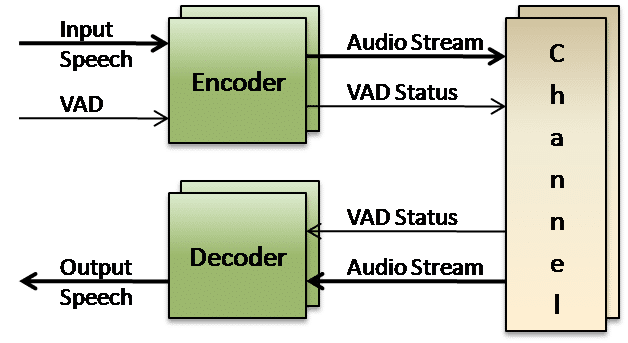
G.729-based embedded variable bit-rate coder:
An 8-32 kbit/s scalable wideband coder bitstream interoperable with G.729 (also known as G.729EV)
- Narrowband/Wideband/Superwideband audio codec
- Mobile, VoIP and Voice Conferencing
- Real-time multi-channel implementation
- Optimized for DSPs, RiSC, CISC processors
- ITU-T G.729.1 compliant
G.729.1 codec is suitable as an internet wideband audio codec for VoIP applications, where normal conversation characteristics may be exploited in order to reduce bandwidth usage.Contact us to discuss your G.729.1 vocoder application requirements.
VOCAL’s G.729.1 source code is optimized for performance on leading DSPs and RISC/CISC processors from TI, ADI, AMD, ARM, Intel and other vendors. VOCAL offers G.729.1 voice compression as a standalone algorithm, as part of a modular software library suite, as well as with a VoIP stack. Custom designs are also available to meet your specific G.729.1 codec needs.
G.729.1
G.729.1 (also known as G.729EV) is extends the ITU-T G.729 speech coder. G.729.1 is an embedded variable bit-rate coder with an 8-32 kbit/s scalable bitstream. G.729EV is interoperable with G.729, G.729 Annex A and G.729 Annex B. G.729.1 is also sometimes known as G.729 Annex J.
G.729.1 supports multiple sampling rates and data rates. At 8kHz sampling, the data rate is variable between 8 and 12kbps. At 16kHz sampling (the default sampling rate), the data rate is variable between 14 and 32kbps. G.729EV requires 20 ms input frames and generates a 12 layer bitstream. The 12 layers correspond to the 12 different bit rates between 8 and 32 kbps. Layer 1 is the 8kbps bit rate, which is compatible with G.729. Layer 2 is the narrowband enhancement layer, while layers 3 through 12 are the wideband enhancements. Layers can be removed by a gateway device or the decoder without the need for additional signaling.
G729EV Annex C introduces the discontinuous transmission (DTX) and comfort noise generation (CNG) for this speech coder. When silence is detected, the encoder generates silence insertion description (SID). The core SID data is compatible with G.729’s Annex B. Additional layers provide more information for the higher bandwidths.
Amendment 6 of G.729.1 (Annex E) adds a superwideband mode at 32kHz sampling, the data rate is variable between 36 and 64kbps, adding potentially up to 5 more layers to the bitstream.
Features
- Compliant with G.729.1 specifications
- Core layer is compatible with G.729
- 17 data rates supported
- Annex C DTX/CNG mode supported
- Full and half duplex modes of operation
- Passes ITU test vectors
- Optimized for high performance on leading edge DSP architectures
- Multichannel implementation
- Multi-tasking environment compatible
Configurations
- DAA interface using linear codec at 8.0/16.0 kHz sample rate
- Direct interface to 8.0 kHz PCM data stream (A-law or μ-law)
- Common compressed speech frame stream interface to support systems with multiple speech coders
- Dynamic speech coders selection if multiple speech codecs available
- Can be integrated with Acoustic Echo Canceller, G.168 Line Echo Canceller and Tone Detection/Regeneration modules
- Available with VoIP stack
- Multiple ports can be executed on a single DSP
More Information
Platforms
![]()
VOCAL’s optimized vocoder software is available for the following platforms. Please contact us for specific vocoder supported platforms and performance data.
| Processors | Operating Systems |
|---|---|
|
|